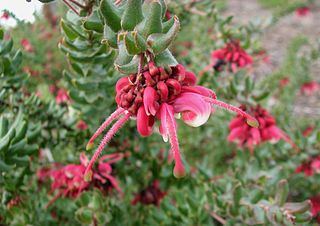
Grevillea baueri, commonly known as Bauer's grevillea, is a species of flowering plant in the family Proteaceae and is endemic to the coastal ranges of south-eastern New South Wales. It is a low, spreading to erect shrub with mostly oblong to egg-shaped leaves with red to pink and cream-coloured or yellow flowers.

Mirbelia oxylobioides, commonly known as mountain mirbelia or sandstone bushpea, is a species of flowering plant in the family Fabaceae and is endemic to south-eastern Australia. It is a low-lying or erect shrub with narrowly elliptic to egg-shaped leaves and orange-yellow and reddish-purple flowers arranged near the end of the branches.

Mirbelia rubiifolia, commonly known as heathy mirbelia, is a species of flowering plant in the family Fabaceae and is endemic to eastern Australia. It is a diffuse, spreading shrub with narrowly egg-shaped to linear, sharply-pointed leaves and clusters of pink to purple flowers.
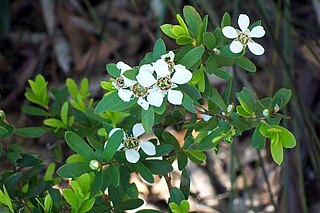
The Leptospermum grandifolium, commonly known as mountain tea-tree or woolly teatree, is a species of shrub or small tree that is endemic to south-eastern Australia. It has elliptical to egg-shaped leaves with a sharp point on the tip, white flowers and relatively large, broadly hemispherical fruit.

Mirbelia speciosa is a species of flowering plant in the family Fabaceae and is endemic to eastern Australia. It is an erect shrub with narrowly linear leaves arranged in whorls of three, and bluish-purple flowers usually arranged singly in leaf axils.
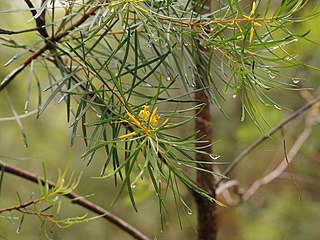
Persoonia virgata is a species of flowering plant in the family Proteaceae and is endemic to coastal areas of eastern Australia. It is usually an erect shrub with smooth bark, hairy young branchlets, linear to narrow spatula-shaped leaves, and yellow flowers borne in groups of up to seventy-five on a rachis up to 230 mm (9.1 in) long that continues to grow after flowering.

Pultenaea blakelyi, commonly known as Blakely's bush-pea, is a species of flowering plant in the family Fabaceae and is endemic to south-eastern continental Australia. It is an erect shrub with sharply-pointed, narrow elliptic to egg-shaped leaves and yellow to orange flowers in open clusters in leaf axils or at the ends of branches.

Pultenaea villosa, commonly known as hairy bush-pea, is a species of flowering plant in the family Fabaceae and is endemic to eastern Australia. It is a shrub with softly-hairy foliage, narrow elliptic to linear, oblong to club-shaped leaves, and yellow-orange and reddish-brown, pea-like flowers.

Leptospermum macrocarpum is a species of shrub that is endemic to the Blue Mountains in New South Wales. It has thin, hard, sometimes gnarled bark on the older stems, broadly elliptical leaves, relatively large white, pink or dark red flowers and large fruit.

Leptospermum parvifolium, commonly known as lemon-scented tea-tree, is a species of shrub that is endemic to eastern Australia. It has thin, rough bark, egg-shaped leaves with the narrower end towards the base, white or pink flowers, and fruit with the remains of the sepals attached but that is shed when the seeds are mature.

Epacris sprengelioides is a species of flowering plant in the family Ericaceae and is endemic to a small area in the Blue Mountains in New South Wales. It is an erect shrub with shaggy-hairy branchlets, more or less erect, narrowly elliptic leaves, and white or cream-coloured, tube-shaped flowers.

Leptospermum sphaerocarpum is a species of shrub that is endemic to New South Wales. It has thin, firm bark, elliptical, sharply-pointed leaves, greenish white or pink flowers and fruit that remain on the plant at maturity.

Leptospermum subglabratum is a species of open shrub that is endemic to a south-eastern New South Wales. It has thin, rough bark, egg-shaped to lance-shaped leaves with the narrower end towards the base, white flowers arranged singly on short side shoots and relatively small fruit that falls from the plant at maturity.
Pultenaea benthamii, commonly known as Bentham's bush-pea, is a species of flowering plant in the family Fabaceae and is endemic to south-eastern continental Australia. It is an erect shrub with sharply-pointed, narrow elliptic to linear leaves and yellow to orange and red flowers in clusters at the ends of branches.
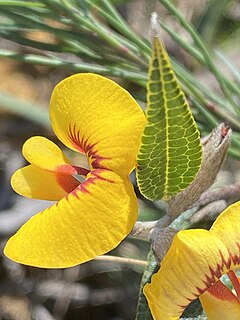
Mirbelia platylobioides is a flowering plant in the family Fabaceae. It is a small, prostrate plant with trailing stems, yellow and red pea flowers and ovate leaves. It is endemic to New South Wales.
Bossiaea dasycarpa is a species of flowering plant in the family Fabaceae and is endemic to a small area in eastern Australia. It is a prostrate or low-lying shrub with narrow oblong to narrow elliptic leaves, and yellow and red flowers.

Pultenaea paleacea, commonly known as chaffy bush-pea, is a species of flowering plant in the family Fabaceae and is endemic to eastern Australia. It is a prostrate to spreading shrub with linear to lance-shaped leaves with the narrower end towards the base, and yellow to orange and red to purple flowers.
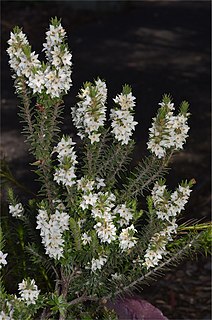
Epacris decumbens is a species of flowering plant in the heath family Ericaceae and is endemic to a restricted area of New South Wales. It is a straggling, low-lying shrub with hairy branchlets, elliptic to egg-shaped leaves, and tube-shaped, white flowers.
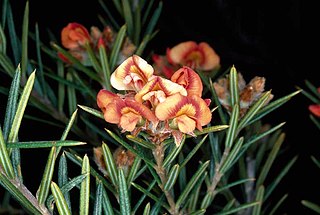
Mirbelia confertiflora is a species of flowering plant in the family Fabaceae and is endemic to eastern Australia. It is a rigid, bushy shrub with linear leaves and yellow to orange flowers arranged in racemes near the end of the branches.

Mirbelia pungens, commonly known as prickly mirbelia, is a species of flowering plant in the family Fabaceae and is endemic to south-eastern continental Australia. It is an erect or prostrate shrub with sharply-pointed linear leaves and orange-red flowers with blue or purple markings.


















